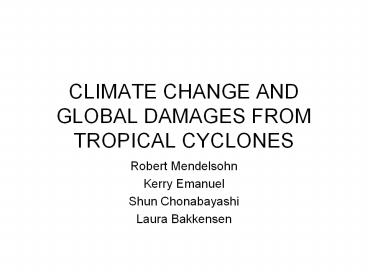CLIMATE CHANGE AND GLOBAL DAMAGES FROM TROPICAL CYCLONES - PowerPoint PPT Presentation
Title:
CLIMATE CHANGE AND GLOBAL DAMAGES FROM TROPICAL CYCLONES
Description:
... The Economics of Effective Prevention Apurva Sanghi Goal of this Study Predict how ... Current analysis at national ... storm surge Restricted land use ... – PowerPoint PPT presentation
Number of Views:151
Avg rating:3.0/5.0
Title: CLIMATE CHANGE AND GLOBAL DAMAGES FROM TROPICAL CYCLONES
1
CLIMATE CHANGE AND GLOBAL DAMAGES FROM TROPICAL
CYCLONES
- Robert Mendelsohn
- Kerry Emanuel
- Shun Chonabayashi
- Laura Bakkensen
2
Acknowledgements
- Funding by World Bank-United Nations Global
Facility for Disaster Reduction Recovery - Report
- Natural Hazards, UnNatural Disasters The
Economics of Effective Prevention - Apurva Sanghi
3
Goal of this Study
- Predict how climate change will affect tropical
cyclones - Reflect underlying changes in vulnerability in
future periods - Estimate damage functions for tropical cyclones
- Measure how climate change affects future
tropical cyclone damages
4
Current and 2100 Baseline Impacts of Extreme
Weather Events
5
Current and Future Extreme Event Damages by
Region
6
Current and Future Deaths by Extreme Event
7
Current and Future Deaths by Region
8
Past Climate Results
- IPCC 1996 estimates CC increases US tropical
cyclone damages by about 0.02 of GDP and world
damages by 0.002 of GWP - Nordhaus 2010 estimates CC doubles US tropical
cyclone damages (0.06 of GDP) - Narita et al 2007 estimate CC doubles world
tropical cyclone damages (0.006 GWP)
9
Integrated Assessment Model
Emissions Trajectory
Climate Scenario
Tropical Cyclone Behavior
Vulnerability Projection
Damage Function
Damage Estimate
10
IPCC Emissions Scenarios
This study
11
Projected Warming
This study
12
Climate Models
- CNRM
- ECHAM
- GFDL
- MIROC
13
Tropical Cyclone Generator
- Step 1 Seed each ocean basin with a very large
number of weak, randomly located cyclones - Step 2 Cyclones are assumed to move with the
large scale atmospheric flow in which they are
embedded, taken from the global climate model - Step 3 Run a detailed cyclone intensity model
for each event, and note how many achieve at
least tropical storm strength - Step 4 Using the small fraction of surviving
events, determine storm statistics.
Details Emanuel et al., Bull. Amer. Meteor.
Soc., 2008
14
500 Synthetic Tracks Coded by Minimum Pressure
15
Change in Tropical Cyclone Power by Ocean Basin
16
Tropical Cyclone Damage Function
Constant Minimum Pressure Income Populat. Density
US 607.5 (10.39) -86.3 (9.96) 0.370 (0.45) 0.488 (1.53)
Global 15.17 (22.77) 0.415 (6.44) -0.21 (3.04)
17
Baseline Tropical Cyclone Damages
- Current Global Damages 20 billion/yr (0.03
GWP) - Future Baseline Damages 55 billion/yr (0.01
GWP) - Baseline increases by 2100 because of higher
income but not as much as GWP - Baseline assumes current climate
18
Current and Future Baseline Damages by Region
19
Estimate Climate Impacts
- Calculate future baseline damages (current
climate) - Calculate future damages with future climate
- Subtract baseline from future damages with future
climate to get net climate impact
20
Climate Change DamagesFrom Tropical Cyclones in
2100 Billion USD/yr/(GWP)
CNRM ECHAM GFDL MIROC
Minimum Pressure 80.1 (0.15) 13.9 (0.03) 78.8 (0.15) 41.6 (0.08)
21
Climate damages by region
22
Climate damage as percent of GDP by region
23
Climate change increases frequency of high damage
storms
24
Limitations
- All steps of the integrated assessment are
uncertain - Possible interaction with sea level rise not yet
taken into account - Current analysis at national level- needs finer
spatial resolution - No explicit adaptation
25
Conclusions-1
- Damages from tropical cyclones almost triple by
2100 from income growth - Climate change likely to double these damages
- Largest CC impacts felt in US and then China
- Island nations will have largest CC impacts as a
fraction of GDP
26
Conclusions-2
- Damages concentrated in large infrequent storms-
10 worst storms will cause 93 of total damages
with CC - Protect against high winds with coastal building
codes - Hard structures (sea walls) are ineffective
protection against infrequent storm surge - Restricted land use at low points along
vulnerable coast
27
(No Transcript)































